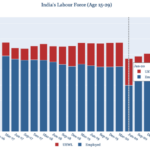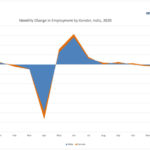CEDA-CMIE Bulletin: Manufacturing employment halves in 5 years
CEDA-CMIE Bulletin No 4: May 2021
With the second wave of the coronavirus pandemic battering India at present, the Indian economic outlook looks bleak for the second year in a row. In 2020-21, India’s real GDP growth is estimated to be minus 8%. This would also put pressure on India’s employment numbers. In previous bulletins, we have analyzed the impact of Covid-19 pandemic on employment, individual and household incomes and expenditures in 2020.
In this CEDA-CMIE Bulletin, we try to take a longer-term view of sector-wise employment in India. We base this on CMIE’s monthly time-series of employment by industry going back to the year 2016. For this bulletin, we have focused on seven sectors, viz. agriculture, mines, manufacturing, real estate and construction, financial services, non-financial services, and public administrative services. These sectors make up for 99% of total employment in the country.
Figure 1
Agriculture now employs more people than five years ago
In figure 2 and 3 (below), we look at four sectors. These are agriculture, financial services, non-financial services, and public administrative services. Non-financial services exclude public administrative services and defense services. Together, these accounted for 69% of total employment in 2016-17 and 78% in 2020-21.
The agriculture sector employed 145.6 million people in 2016-17. This increased by 4% to reach 151.8 million in 2020-21. While it constituted 36% of all employment in 2016-17, the figure rose to 40% in 2020-21, underlining the sector’s importance for the Indian economy. Employment in agriculture has been on the rise over the last two years with year-on-year (YoY) growth rates of 1.7% in 2019-20 and 4.1% in 2020-21.
Figure 2
119.7 million Indians were employed in the non-financial services in 2016-17 (excluding those in public administrative services and defense services) (Figure 3). This number rose by 6.7% to reach 127.7 million in 2020-21. The financial services sector employed 5.3 million people in 2016-17 and this grew by 9% to 5.8 million in 2020-21.
Public administrative services employed 9.8 million people in 2016-17 but it decreased by 19% to 7.9 million in 2020-21.
Figure 3
Manufacturing employment nearly half of what it was five years ago
In figure 4, we look at employment in manufacturing, real estate & construction, and mining sectors. Together these sectors accounted for 30% of all employment in 2016-17 which came down to 21% in 2020-21.
Manufacturing accounts for nearly 17% of India’s GDP but the sector has seen employment decline sharply in the last 5 years. From employing 51 million Indians in 2016-17, employment in the sector declined by 46% to reach 27.3 million in 2020-21. This indicates the severity of the employment crisis in India predating the pandemic.
On a YoY basis, it employed 32% fewer people in 2020-21 over 2019-20. It had seen a growth of 1% (YoY) in 2019-20. This has happened despite the Indian government’s push to improve manufacturing in the country with the ‘Make in India’ project. Under the project, India sought to create an additional 100 million manufacturing jobs in India by 2022 and to increase manufacturing’s contribution to GDP to 20% by 2025.
Instead of increasing employment in the sector, we have seen a sharp decline over the last 5 years. When we look closely at industries that make the manufacturing sector, we find that this is a secular decline in employment across all sub-sectors, except chemical industries.
All sub-sectors within manufacturing registered a longer-term decline.
Real estate and construction sector has also seen a sharp dip in employment over the five-year period from 2016-17 to 2020-21. From employing 69 million Indians in 2016-17, employment in the sector dipped by 25% to reach 53.7 million in 2020-21. The sector saw employment dip by 12% in 2020-21 (YoY) and 2.1% in 2019-20 (YoY). In recent years, the sector has been beset by issues of inventory pile up, delivery delays and developer failures. This is reflected in the employment numbers. The troubled industry has been hit further by the coronavirus pandemic in 2020-21.
Mining industry has also seen employment crash by 38% over the five-year period between 2016-17 and 2020-21. From employing 1.4 million people in 2016-17, the sector employed only 0.88 million people in 2020-21. India’s economic slowdown may be the reason to blame for the decline in employment in the sector. With demand falling in the steel, power and construction industries, mining has suffered a hit.
Figure 4
While the real estate and construction sector drove employment growth between 2004-11, it saw a sharp decline between 2016-17 and 2020-21. We also see that there has been hardly any source of growth in employment in this period. This is reflected in the 7% decline in overall employment in the country from 407 million in 2016-17 to 378 million in 2020-21.
These numbers show that the employment crisis in India predates the pandemic; the Covid-19 pandemic has made the jobs plight even more severe.
If you wish to republish this article or use an extract or chart, please read CEDA’s republishing guidelines.







